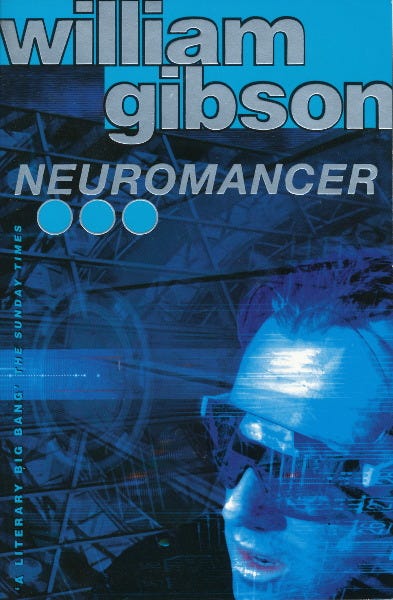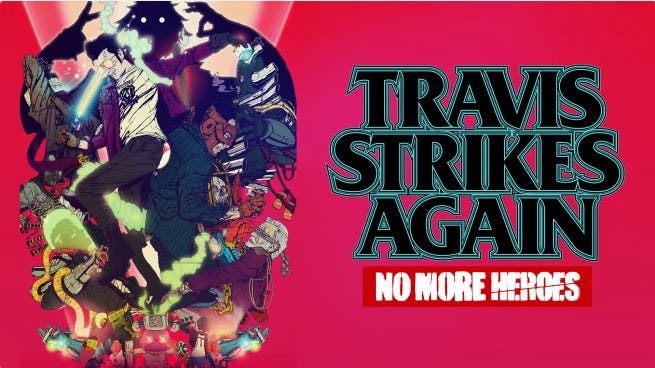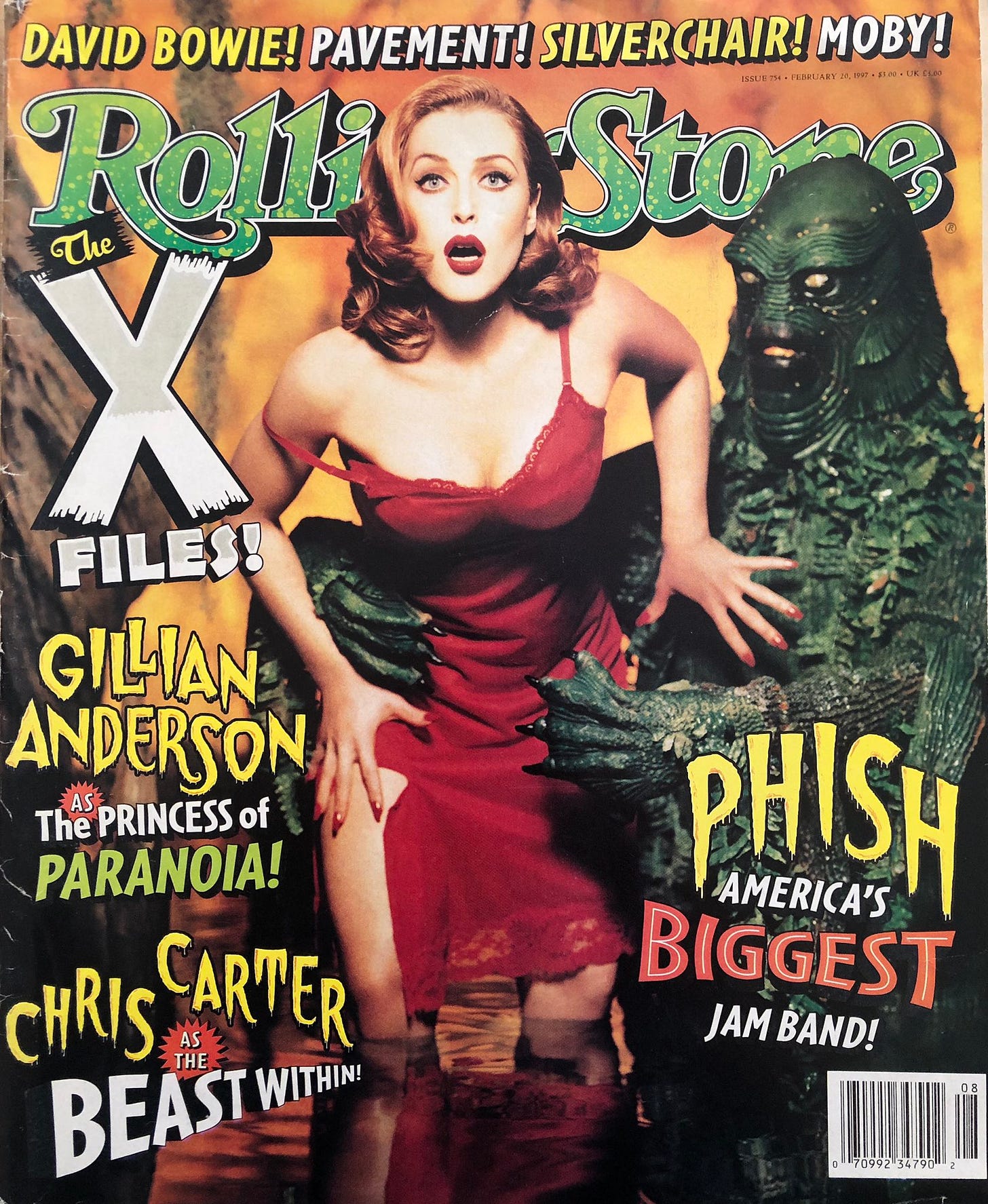HYPERFIX - February 3rd 2023 Edition - Better Living Through Technology
William Gibson/Suda51/X-Files
Ate a big burrito right before sitting down to write this. So fucked up that I can just buy one of those. They should be put them behind glass like a diamond ring or a bedazzled gun. You should have to go to the counter and point to the burrito and say “I want that.” Then the guy should have to unlock the case and hand you the burrito and then you can’t leave until you finished it. And you have to stand up the entire time. I wolfed that fucker down too. Five minutes flat, maybe fewer.
What I'm Reading: Neuromancer
It's too bad that modern audiences know what a computer is and know what its functions will look like. William Gibson's Neuromancer is such an excellent, imaginative sci-fi pulp thriller that blows up the possibilities of a nascent technology to maximalist proportions. Neuromancer sees revolutionary potential in the computer, in the hacker and in AI. With a blissful veil of ignorance over Gibson's head, he envisions a dark modern future whose salvation may come through a synthesis between humanity and technology. Gibson’s cyberpunk style is amped up, feverish noir perfect for caffeinated, jittery reading sessions. The book’s pacing is speedy with hacker protagonist Case spending the first chunk of the book jet-setting around what’s left of the modern world before going in to perform a heist that no party understands the particulars of. It’s engaging work, tightly told and written in vivid detail.
This was my fourth read of Neuromancer. It's a story I can return to over and over again. Every time I pick up my trade paperback copy, which fits snugly into the inside pocket of my jacket, I want to reread it. It goes down easy and I always discover a detail I missed in Gibson's nested descriptions of ravaged cities, nightlife districts illuminated by neon and his fantastical, hyper-real cyberspace. On this read, I took in the M.C. Escheresque, space age design of the orbiting casino city, Freeside. Its geography is explicitly unnatural, a symbol of man’s dominance over nature that serves only a getaway destination for the rich and fabulous;
“There was a brilliant slash of light somewhere above them too bright, and the recorded blue of the Cannes sky. He knew that sunlight was pumped in with a Lado-Acheson system whose two-millimeter armature ran the length of the spindle, that they generated a rotating library of sky effects around it, that if the sky were turned off, he’d stare up past the armature of light to the curves of lakes, rooftops of casinos, other streets….”
Among the most impressive and inspiring qualities of Neuromancer is that it is a new thing sculpted out of the old. Gibson used Escape From New York as inspiration, had his vision laid out before him by Syd Mead's designs in Blade Runner, and sprinkled in references to the 70s punk music scene that he adored. From those creative oases, he implemented his own concerns about how technology would transform human identity and how existing economic and political discrepancies would be exacerbated by advancements in technology. One of the main inspirations for Neuromancer was an exchange in Escape From New York that has minimal plot relevance but sets up an entire world beyond what the viewer sees onscreen.
This approach to world-building is all over Neuromancer. The Sprawl, the collected metropolitan area consisting of most of Eastern North America, is not physically visited but the reader can infer an economic and political history to the region, one that's adapted from their prior knowledge of 1970s America. The material world in the Sprawl is an exaggerated version of our own reality, one that's just a few minutes into the future.
In contrast, Gibson's cyberspace is an intentionally dislocated space. It is not supposed to have a previous frame of reference for the reader. Gibson is famously, ironically, a relative luddite. He had never touched a computer before writing Neuromancer on his 1927 Hermes typewriter. For Gibson, cyberspace is a place of total invention. For his protagonist, Case, it's a space of generative possibility. For the reader, it's anew media - one composed of HUDs and three-dimensional shapes, dynamically interactive objects that spontaneously generate from blank space. From this location, the physically weak and charisma deficient can become active agents of radical change, creating mayhem and revolution through technological subversion. Gibson’s hackers can infiltrate castles, corporate offices and even others’ bodies all from the comfort of their “deck.” What’s inside Gibson’s decks is beyond even the imagineering of sci-fi contemporariers like TRON.
“Disk beginning to rotate, faster, becoming a sphere of pale gray. Expanding…And flowed, flowered, for him, fluid neon origami trick, the unfolding of his distanceless home, his country, transparent 3D chessboard expanding to infinity. Inner eye opening to the stepped scarlet pyramid of the Eastern Seaboard Fussion Authority burning beyond the green cubes of Mitsubishi Bank of America, and high and very far away he saw the spiral arms of military systems, forever beyond his reach.”
For less historically immersed readers, Neuromancer's style could read as derivative or old fashioned - "console cowboys", "razorgirls" and talk of “punching in” could elicit eye rolls for the starched shirts. Yet, it cannot be understated how much Neuromancer coded tech and sci-fi aesthetics after its release. When it was first released in 1984, Gibson's ideas required audience participation. In 2023, cyberpunk is everywhere. It's in our movies, games, music, clothing, advertising, and it only vaguely apes what Gibson laid out in Neuromancer. What Gibson described as cyberspace has become what we recognize as the internet - and it couldn't be more different. Instead of being a user designed place of self-expression, the internet is mostly an apparatus for data collection of private individuals. It has no "place" and its functions are guided not by users, but by tech oligarchs who control those platforms. Gibson’s notion of what computers could look like is precious in its naiveté but he recognized that corporations would find ways to control this new technology and Neuromancer is about finding a method to wrest that control away from them.
Neuromancer is good escapist pulp lit not just because it’s an immersive read with a great setting and a gripping plot but because it now acts as a window to a lost future. Without getting too deep in my Limited Edition Frosted Mark Fisher cups (exclusive to participating McDonalds), Neuromancer asks its readers to envision a new world, a world so similar to their own but with a floating variable that could invite transformative change. The two sequels to Neuromancer, Count Zero and Mona Lisa Overdrive, play around in Gibson’s Sprawl a little bit more but Neuromancer functions as a tight, self-contained exploration of how our relationship with technology could develop without being an old Frankenstein tale of our creation coming back to hurt us. It’s also a cool story about a loser who gets to hang out with a hot lady mercenary with knife hands and a pair of space Rastafarians and that’s good fun.
Additional Reading & Viewing:
An Interview with William Gibson conducted by Larry McCaffrey (1991)
1990s Kid's Guide to the Internet
How to Send an Email - 1983 - Thames TV
What I'm Playing: Travis Strikes Again: No More Heroes
When Travis Strikes Again was first announced alongside the Nintendo Switch in 2017, its very existence was a symbolic victory. Grasshopper Manufacture, the cult studio headed by Goichi Suda, known for their work on beloved standard-definition hits like Killer7 and No More Heroes had stumbled in the era of HD development. Like so many semi-independent Japanese developers, they found themselves leapfrogged by their Western counterparts and forced to make creative compromises to secure partnerships with American companies. Few companies made a more devastating handshake than Grasshopper whose disastrous partnership with Electronic Arts for Shadows of the Damned nearly sunk the studio, allegedly sending Suda into a spiraling creative funk. So when Suda took the stage at Nintendo’s conference, it sent a message - independent Japanese development was back.
It's important to give context to Travis Strikes Again because the actual game is pretty shallow. Does it particularly matter if a game is just kinda alright if the whole of the experience is worthwhile? This thought always bounces around my head when I play Goichi Suda's games and Travis Strikes Again is no different. Like most of Grasshopper’s output, the combat is perfunctory and repetitive. Thankfully it’s doled out in digestible increments and establishes a basic rhythm that flirts with being satisfying. The usual Suda aesthetic beats are here for comfort; a eclectic soundtrack with drum-and-bass forming its backbone, opaque metatextual dialogue, and a grim, sophomoric sense of humor. This recipe works to ease the harsh flavors of the original No More Heroes and The Silver Case and it works here too.
I suppose the game would be more fun with the very much encouraged co-op feature. The bland overhead beat ‘em up gameplay could certainly use a partner to mitigate the tedium though I remain unsure if the game’s structure is inviting or enticing to outside players. Although the gameplay’s simple, the rest requires either structured onboarding or total ambivalence. This sort of oversight is why this newsletter takes the structure that it does though I’ve noticed that few professional reviewers or casual fans pursued the co-op mode which suggests that the whole co-op endeavor exists for the privileged few who know a No More Heroes fan they can stand to be around.
After the credits rolled, I was excited to do the post-game DLC but as I filed through the game's levels and setpieces in my mental rolodex, I did not see myself wanting to return to any previous levels for a very long time. That's okay though because one playthrough was enough. Travis Strikes Again is a game for its creator, about Suda reclaiming his work for himself. Although it starts as a goofy homage to indie games, namely the ultra-violent Hotline Miami, as it goes on it transforms into a sincere, thoughtful narrative about moving on from personal failure. It keeps the sardonic, over-the-top beats of its predecessors but it's transparently about its creator falling out of love with his job and learning to appreciate his failures.
In a business as cutthroat as video games, there is an incredible amount of cynicism in the pitch and design of them. Unlike A.A. Milne and Winnie the Pooh, Sonic the Hedgehog did not come about from the creator's relationship with their child, but from an internal design competition for the company's new mascot. Suda's games were the antithesis of that - creator-driver concepts that were often outright hostile to players and by extension, financial success. They were celebrated critically for their auteur sensibilities and found a dedicated cult audience. The aforementioned Electronic Arts collaboration, Shadows of the Damned, was Suda compromising and sacrificing creative autonomy for the opportunity to make a "studio game”, to finally be recognized by the mainstream for his studio’s talent and it was a highly public professional failure that jeopardized his company and his legacy.
Depending on who you ask, Shadows of the Damned is one of the best playing games in Grasshopper’s catalogue - I haven’t played it - but diehard fans noted how it marked the start of a period of decline. Grasshopper did develop a couple of HD titles after SoTD but much of it felt like pastiche work lacking the spark seen before. Importantly, many of these projects were collaborations - with Electronic Arts, WB Games, Microsoft, Digital Reality and others. Grasshopper had been scouted for their unique style and sold that style out to all of these companies. They gambled their identity for survival - the 2010s being an especially fraught period for developers - and Travis Strikes Again sees Grasshopper making it out to the other side.
The sixth level of Travis Strikes Again is a pseudo-sequel to Shadows of the Damned. It’s still in the style of TSA but set in the same universe with the same characters. Throughout TSA, characters from across Suda’s games make cameos but it isn’t until this level that this sort of expanded universe approach begins to mean anything. It’s one thing for Suda to get the rights of his first game back from a nearly defunct holding company, it’s another for him to wrestle his ideas from a conglomerate like Electronic Arts, a company so sticky that it has a Wikipedia page dedicated to its acquisitions. After a decade of making games for others, Travis Strikes Again issues a bold new mission statement - that Grasshopper is making games for itself again.
I appreciate its bleeding heart but Travis Strikes Again’s gameplay does hinder my appreciation. There are better syntheses between gameplay and narrative themes elsewhere in his work. It’s Suda’s most mature, reflective work and more generous fans will be enamored with how Suda mixes and melds references to his old games in with his reverence for the new hot indie titles - some of which he influenced. It is nice when an elder statesman of the medium comes down to gives his blessings and Suda fires his out with a t-shirt gun. Ultimately, I’d recommend it to hardcore fans only. Suda’s renewed confidence is sweet to see but you’ve got to love the man before you’ll love the game. Killer7 is on Steam, start there.
Suda51 Breaks Down His Iconic Career - Gamespot - 2019
Goichi Suda Interview - Conducted by Tim Rogers - 2019
X-Files Corner: Unrequited
Another slack week for the X-Files Corner. Unrequited was an episode about a Vietnam veteran who is killing military top brass and can disappear at a moment’s notice. He can exploit blind spots in people’s field of vision I guess but it also might be supernatural or it could be a military conspiracy. Maybe all three, some type of supernatural practical conspiracy gumbo. It’s also like, a commentary of how America’s vets are invisible and how their reputation is laundered by the military for glory but the individual is forgotten. Whatever man, you ever watch First Blood? I didn’t watch any other episodes this week. I’m keeping the dust out of the corner but Chris Carter and company keep emptying the vacuum.
Other Recommendations:
Film & Television:
Christine (John Carpenter - 1983): John Carpenter in the 80s was on another level. He was like King Midas but without all the bad stuff. I’d say Christine is one of his weaker films of the era but I lay the blame solely on Stephen King. Something about his sledgehammer subtle theming bugs the hell out of me. Carpenter effectively turns the car into a Michael Myers figure which is impressive given how poorly a 1958 Plymouth Fury takes a corner.
Monster (Masayuki Kojima, written by Naoki Urasawa - 2004): Well known, ultra grim psychological thriller anime that was recently added to Netflix. I’m about ten episodes deep and not much has happened. Has anyone done any research into why watching a 22 minute anime episode feels like it takes less time than watching a 22 minute episode of a sitcom? Might have something to do with the minimal drama per episode, it only ratchets up at specific moments. Family Matters had whole emotional arcs in between commercial breaks.
Writing:
The Lady in the Lake (Raymond Chandler - 1943): Like Neuromancer, goes down easy. My edition’s cover has a hand popping out of the lake with a fey limpwrist gesture that never fails to make me laugh. One crazy thing about this book is that the entire book takes place within three days. They drive through so much of California, how do they do it?
Music:
In My Element (Robert Glasper - 2007): As with all jazz albums, this one was recommended to me years ago and I’m just now getting around to actually listening to it in full. Poppy and pleasant for a jazz album, my former coworker who recommended this to me is two for two.
Sentimental Hygiene (Warren Zevon - 1987): After decades of being slighted by Jann Wenner, Zevon’s finally being nominated for induction into the Rock & Roll Hall of Fame. It’s a bullshit honor but it might matter a lot to some people whose opinions are worth more than mine so use it as opportunity to listen to Boom Boom Mancini.




